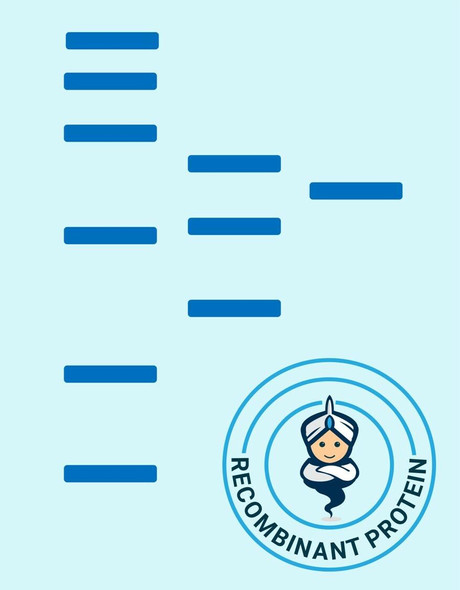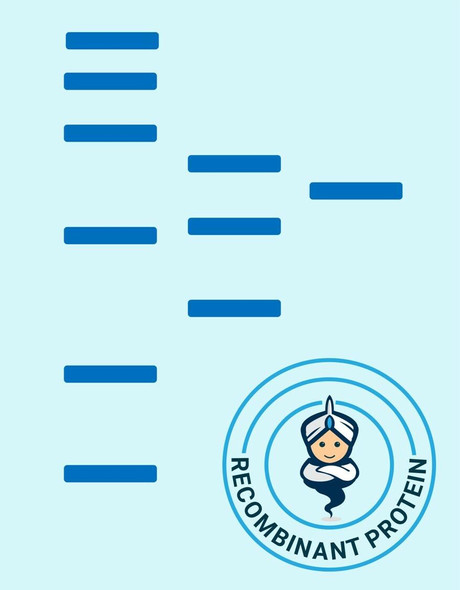Description
| Product Name: | Human USE1 Recombinant Protein |
| Product Code: | RPPB5092 |
| Size: | 10µg |
| Species: | Human |
| Target: | USE1 |
| Synonyms: | Vesicle transport protein USE1, Putative MAPK-activatingprotein PM26, USE1-like protein, p31, USE1L, MDS032, Q-SNARE, SLT1, SNARE-LikeTail-Anchored Protein 1 Homolog, Protein P31. |
| Source: | Escherichia Coli |
| Physical Appearance: | Sterile Filtered clear solution. |
| Formulation: | USE1 protein solution (0.25mg/ml) containing 20mMTris-HCl buffer (pH8.0), 10% glycerol, 0.1M NaCl and 1mM DTT. |
| Stability: | Store at 4°C if entire vial will be used within 2-4 weeks. Store, frozen at -20°C for longer periods of time. For long term storage it is recommended to add a carrier protein (0.1% HSA or BSA).Avoid multiple freeze-thaw cycles. |
| Purity: | Greater than 80.0% as determined by SDS-PAGE. |
| Amino Acid Sequence: | MGSSHHHHHH SSGLVPRGSH MGSMAASRLE LNLVRLLSRC EAMAAEKRDP DEWRLEKYVG ALEDMLQALKVHASKPASEV INEYSWKVDF LKGMLQAEKL TSSSEKALAN QFLAPGRVPT TARERVPATK TVHLQSRARYTSEMRSELLG TDSAEPEMDV RKRTGVAGSQ PVSEKQSAAE LDLVLQRHQN LQEKLAEEML GLARSLKTNT LAAQSVIKKD NQTLSHSLKMADQNLEKLKT ESERLEQHTQ KSVN |
USE1Belongs to the USE1 family, this protein is a vesicle transport protein. USE1is a component of a SNAREcomplex consisting of STX18, USE1L, BNIP1/SEC20L and SEC22B. In additionUSE1 interacts directly with STX18. SNAREmay be involvedin targeting and fusion of Golgi-derived retrograde transport vesicles with theER. Diseases associated with USE1 comprise dysentery and hemolytic-uremicsyndrome. Among its related super-pathways are Nicotine Pathway (DopaminergicNeuron) and Pharmacodynamics. GO annotations related to this gene includeprotein binding.
USE1 Human Recombinant produced in E.Coli is a single, non-glycosylated polypeptide chain containing 254 amino acids (1-231 a.a) and having a molecular mass of 28.3kDa.USE1 is fused to a 23 amino acid His-tag at N-terminus & purified by proprietary chromatographic techniques.
| UniProt Protein Function: | USE1L: SNARE that may be involved in targeting and fusion of Golgi-derived retrograde transport vesicles with the ER. Belongs to the USE1 family. 3 isoforms of the human protein are produced by alternative splicing. |
| UniProt Protein Details: | Protein type:Vesicle; Membrane protein, integral Chromosomal Location of Human Ortholog: 19p13.11 Cellular Component: endoplasmic reticulum; endoplasmic reticulum membrane; lysosome Molecular Function:protein binding Biological Process: ER to Golgi vesicle-mediated transport; lysosomal transport; protein catabolic process; retrograde vesicle-mediated transport, Golgi to ER; secretion by cell |
| UniProt Code: | Q9NZ43 |
| NCBI GenInfo Identifier: | 296452858 |
| NCBI Gene ID: | 55850 |
| NCBI Accession: | Q9NZ43.2 |
| UniProt Secondary Accession: | Q9NZ43,Q8NCK1, Q9BRT4, |
| UniProt Related Accession: | Q9NZ43 |
| Molecular Weight: | 15,063 Da |
| NCBI Full Name: | Vesicle transport protein USE1 |
| NCBI Synonym Full Names: | unconventional SNARE in the ER 1 |
| NCBI Official Symbol: | USE1�� |
| NCBI Official Synonym Symbols: | D12; P31; SLT1; MDS032�� |
| NCBI Protein Information: | vesicle transport protein USE1 |
| UniProt Protein Name: | Vesicle transport protein USE1 |
| UniProt Synonym Protein Names: | Putative MAPK-activating protein PM26; USE1-like protein; p31 |
| Protein Family: | Protein transport protein |
| UniProt Gene Name: | USE1�� |
| UniProt Entry Name: | USE1_HUMAN |






